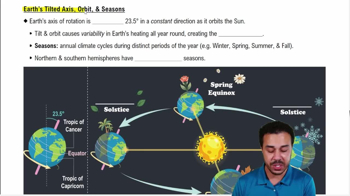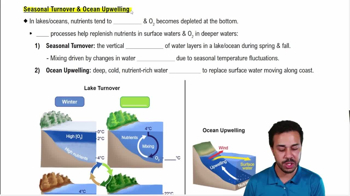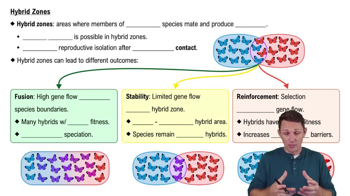Table of contents
- 1. Introduction to Biology2h 42m
- 2. Chemistry3h 40m
- 3. Water1h 26m
- 4. Biomolecules2h 23m
- 5. Cell Components2h 26m
- 6. The Membrane2h 31m
- 7. Energy and Metabolism2h 0m
- 8. Respiration2h 40m
- 9. Photosynthesis2h 49m
- 10. Cell Signaling59m
- 11. Cell Division2h 47m
- 12. Meiosis2h 0m
- 13. Mendelian Genetics4h 44m
- Introduction to Mendel's Experiments7m
- Genotype vs. Phenotype17m
- Punnett Squares13m
- Mendel's Experiments26m
- Mendel's Laws18m
- Monohybrid Crosses19m
- Test Crosses14m
- Dihybrid Crosses20m
- Punnett Square Probability26m
- Incomplete Dominance vs. Codominance20m
- Epistasis7m
- Non-Mendelian Genetics12m
- Pedigrees6m
- Autosomal Inheritance21m
- Sex-Linked Inheritance43m
- X-Inactivation9m
- 14. DNA Synthesis2h 27m
- 15. Gene Expression3h 20m
- 16. Regulation of Expression3h 31m
- Introduction to Regulation of Gene Expression13m
- Prokaryotic Gene Regulation via Operons27m
- The Lac Operon21m
- Glucose's Impact on Lac Operon25m
- The Trp Operon20m
- Review of the Lac Operon & Trp Operon11m
- Introduction to Eukaryotic Gene Regulation9m
- Eukaryotic Chromatin Modifications16m
- Eukaryotic Transcriptional Control22m
- Eukaryotic Post-Transcriptional Regulation28m
- Eukaryotic Post-Translational Regulation13m
- 17. Viruses37m
- 18. Biotechnology2h 58m
- 19. Genomics17m
- 20. Development1h 5m
- 21. Evolution3h 1m
- 22. Evolution of Populations3h 53m
- 23. Speciation1h 37m
- 24. History of Life on Earth2h 6m
- 25. Phylogeny2h 31m
- 26. Prokaryotes4h 59m
- 27. Protists1h 12m
- 28. Plants1h 22m
- 29. Fungi36m
- 30. Overview of Animals34m
- 31. Invertebrates1h 2m
- 32. Vertebrates50m
- 33. Plant Anatomy1h 3m
- 34. Vascular Plant Transport1h 2m
- 35. Soil37m
- 36. Plant Reproduction47m
- 37. Plant Sensation and Response1h 9m
- 38. Animal Form and Function1h 19m
- 39. Digestive System1h 10m
- 40. Circulatory System1h 49m
- 41. Immune System1h 12m
- 42. Osmoregulation and Excretion50m
- 43. Endocrine System1h 4m
- 44. Animal Reproduction1h 2m
- 45. Nervous System1h 55m
- 46. Sensory Systems46m
- 47. Muscle Systems23m
- 48. Ecology3h 11m
- Introduction to Ecology20m
- Biogeography14m
- Earth's Climate Patterns50m
- Introduction to Terrestrial Biomes10m
- Terrestrial Biomes: Near Equator13m
- Terrestrial Biomes: Temperate Regions10m
- Terrestrial Biomes: Northern Regions15m
- Introduction to Aquatic Biomes27m
- Freshwater Aquatic Biomes14m
- Marine Aquatic Biomes13m
- 49. Animal Behavior28m
- 50. Population Ecology3h 41m
- Introduction to Population Ecology28m
- Population Sampling Methods23m
- Life History12m
- Population Demography17m
- Factors Limiting Population Growth14m
- Introduction to Population Growth Models22m
- Linear Population Growth6m
- Exponential Population Growth29m
- Logistic Population Growth32m
- r/K Selection10m
- The Human Population22m
- 51. Community Ecology2h 46m
- Introduction to Community Ecology2m
- Introduction to Community Interactions9m
- Community Interactions: Competition (-/-)38m
- Community Interactions: Exploitation (+/-)23m
- Community Interactions: Mutualism (+/+) & Commensalism (+/0)9m
- Community Structure35m
- Community Dynamics26m
- Geographic Impact on Communities21m
- 52. Ecosystems2h 36m
- 53. Conservation Biology24m
48. Ecology
Introduction to Ecology
Problem 1
Textbook Question
Explain why the northern United States experiences a cold season in winter and a warm season in summer?
 Verified step by step guidance
Verified step by step guidance1
Understand that the Earth's axis is tilted at an angle of approximately 23.5 degrees relative to its orbit around the Sun. This tilt is the primary reason for seasonal changes.
During the summer in the northern hemisphere, the Earth's tilt causes the northern hemisphere to be oriented toward the Sun. This results in more direct sunlight and longer daylight hours, leading to warmer temperatures.
In contrast, during the winter in the northern hemisphere, the Earth's tilt causes the northern hemisphere to be oriented away from the Sun. This results in less direct sunlight and shorter daylight hours, leading to colder temperatures.
Recognize that the intensity of sunlight (solar radiation) is a key factor. When sunlight strikes the Earth at a steep angle during summer, it is concentrated over a smaller area, increasing warmth. In winter, sunlight strikes at a shallow angle, spreading over a larger area and reducing warmth.
Consider the role of Earth's orbit. While the Earth's distance from the Sun changes slightly during its elliptical orbit, this has a minimal effect on seasons compared to the axial tilt. The tilt is the dominant factor in creating the cold and warm seasons experienced in the northern United States.
 Verified video answer for a similar problem:
Verified video answer for a similar problem:This video solution was recommended by our tutors as helpful for the problem above
Video duration:
47sPlay a video:
Was this helpful?
Key Concepts
Here are the essential concepts you must grasp in order to answer the question correctly.
Earth's Tilted Axis
The Earth's axis is tilted at an angle of approximately 23.5 degrees relative to its orbit around the Sun. This tilt is crucial in determining the intensity and duration of sunlight received at different latitudes throughout the year, leading to seasonal variations. During winter, the northern hemisphere is tilted away from the Sun, resulting in shorter days and less direct sunlight, causing colder temperatures.
Recommended video:
Guided course

Earth’s Tilted Axis, Orbit, & Seasons
Seasonal Changes
Seasons are caused by the axial tilt of the Earth and its orbit around the Sun. As the Earth travels along its elliptical path, different regions receive varying amounts of sunlight at different times of the year. In the northern United States, this results in cold winters when the region is tilted away from the Sun and warm summers when it is tilted towards the Sun, leading to significant temperature differences.
Recommended video:
Guided course

Seasonal Turnover & Ocean Upwelling
Climate Zones
The northern United States falls within temperate climate zones, characterized by distinct seasonal changes. These zones experience a wide range of temperatures and weather patterns throughout the year, influenced by factors such as latitude, altitude, and proximity to bodies of water. The contrast between cold winters and warm summers is a hallmark of temperate climates, shaped by the Earth's axial tilt and seasonal sunlight variations.
Recommended video:

Hybrid Zones
Related Videos
Related Practice
Multiple Choice
Plankton consists of __________.
1299
views


